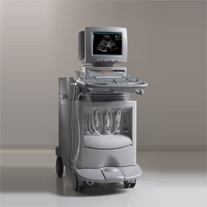Medical Ultrasound Imaging
Tuesday, 7 May 2024
'Ultrasound Physics' Searchterm 'Ultrasound Physics' found in 13 articles 1 term [ • ] - 10 definitions [• ] - 2 booleans [• ]Result Pages : • Ultrasound Physics
Ultrasound physics is based on the fact that periodic motion emitted of a vibrating object causes pressure waves. Ultrasonic waves are made of high pressure and low pressure (rarefactional pressure) pulses traveling through a medium. Properties of sound waves: The speed of ultrasound depends on the mass and spacing of the tissue molecules and the attracting force between the particles of the medium. Ultrasonic waves travels faster in dense materials and slower in compressible materials. Ultrasound is reflected at interfaces between tissues of different acoustic impedance e.g., soft tissue - air, bone - air, or soft tissue - bone. The sound waves are produced and received by the piezoelectric crystal of the transducer. The fast Fourier transformation converts the signal into a gray scale ultrasound picture. The ultrasonic transmission and absorption is dependend on: See also Sonographic Features, Doppler Effect and Thermal Effect. •  From Siemens Medical Systems;
From Siemens Medical Systems;'The Acuson Sequoia™ ultrasound system's unique use of ultrasound physics will allow you to see aspects of anatomy and physiology like never before. Its unrivaled performance is based on four technology cornerstones. To understand these technologies is to appreciate just how far this platform has advanced the science of ultrasound.' Specifications for this system will be available soon. •
(Z) The acoustic impedance is dependent on the density of the material in which sound is propagated through. When an ultrasonic wave crosses an interface between tissues with different acoustic impedance, the wave divides in 2 components, and the energy of the reflected components directly relates with the acoustic impedance. The greater the impedance the more dense the material, and the greater the difference in acoustic impedance between two adjacent tissues the more reflective will be their boundary. The acoustic impedance (the unit is 'Rayl') is the product of the sound velocity and the physical dense. The acoustic impedance is very high between air or bone and other body tissues, therefore not enough energy crosses these interfaces, and no information can be collected from organs placed behind them. See also Mirror Artifact, Reverberation Artifact, Cross Talk and Ultrasound Physics. Further Reading: Basics: •
(EUS) Endoscopic ultrasound uses a small probe that is inserted in the rectum either through a proctoscope or by itself. During the test biopsies of any suspicious areas are possible. The usual necessary preparation is an enema to empty the rectum. Endoscopic ultrasound provides additional information about rectal polyps, rectal cancer, perianal infection, and sphincter muscle injuries and improves the selection of patients for local excision. Transrectal echography using a high-frequency transducer is a well established method for preoperative rectal carcinoma assessment. Endoscopic scanning is limited by the ultrasound physics (depth and axial resolution) of the endocavitary probe. Therefore, the combination of endoscopic and transcutaneous ultrasound is most favorable. •
A piezoelectric crystal changes the physical dimensions when subjected to an electric field. When deformed by external pressure, an electric field is created across the crystal. Piezoelectric ceramic and crystals are used in ultrasound transducers to transmit and receive ultrasound waves. The piezoelectric crystal in ultrasound transducers has electrodes attached to its front and back for the application and detection of electrical charges. The crystal consists of numerous dipoles, and in the normal state, the individual dipoles have an oblique orientation with no net surface charge. In ultrasound physics, an electric field applied across the crystal will realign the dipoles and results in compression or expansion of the crystal, depending on the direction of the electric field. For the transmission of a short ultrasound pulse, a voltage spike of very short duration is applied, causing the crystal to initially contract and then vibrate for a short time with its resonant frequency. See also Composite Array, Transducer Pulse Control, and Temporal Peak Intensity. Result Pages : |
Medical-Ultrasound-Imaging.com
former US-TIP.com
Member of SoftWays' Medical Imaging Group - MR-TIP • Radiology TIP • Medical-Ultrasound-Imaging
Copyright © 2008 - 2024 SoftWays. All rights reserved.
Terms of Use | Privacy Policy | Advertise With Us
former US-TIP.com
Member of SoftWays' Medical Imaging Group - MR-TIP • Radiology TIP • Medical-Ultrasound-Imaging
Copyright © 2008 - 2024 SoftWays. All rights reserved.
Terms of Use | Privacy Policy | Advertise With Us
[last update: 2023-11-06 01:42:00]




